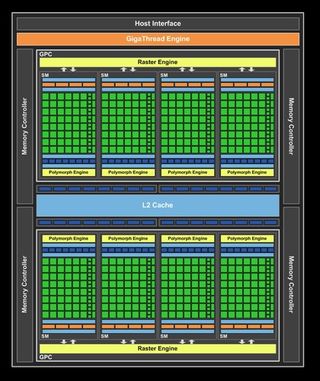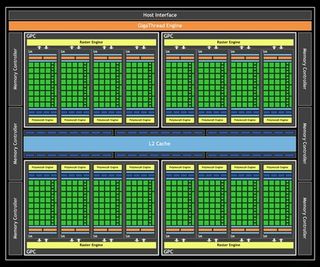Why you can trust TechRadar

What we're talking about here is a completely different GPU than we've seen so far in Nvidia's DirectX 11 cards.
Admittedly it is still based around the Fermi architecture, and it's still going to go by the Graphics Fermi (GF) moniker, but the GF104 is a far more streamlined chip compared to the GF100.
Nvidia's making a lot of fuss about the fact that it's redesigning the GTX 460's GPU rather than simply chopping the GTX 480's GPU in half, as it claims it could've done.
And yes, they probably could have cut the chip in half for the GTX 460, but that would have only created a more half-arsed chip than anyone would be willing to pay £200 for.
The GTX 460's rejigged GPU though may still sound like Nvidia has just chopped the GTX 480's already cut-down GF100 chip in half, with only seven streaming multiprocessors (SMs) against the older card's fourteen, but inside things have most definitely changed.

These SMs are the units that hold the myriad CUDA cores (previously known as shader processors), special function units (SFUs), texture mapping units (TMUs) and the polymorph engines that contain the all-important tessellation grunt.

The SMs of the GF100 chips contain a maximum of 32 shader cores, four SFUs and four TMUs. In the GTX 460 chip though NVIDIA has squeezed another 16 CUDA cores into each SM and upped the SFU and TMU counts to eight per SM.
Each of these SMs has also had some CPU-like extra multi-threading goodness injected into them in the shape of an extra couple of dispatch units in each of them.
This should mean more instructions can be picked up and run by an individual streaming multiprocessor than with the original GF100.
This means despite a drop of four SMs, compared to the GTX 465's cut-down GF100 chip, the more optimised architecture of this new GPU makes it a far more interesting proposition.
Whether this is a result of Nvidia having worked with its new technology for long enough to see where it can improve things, or whether the condensing of more cores and units into each SM is a way to better the previously awful yields of the full GF100 GPUs, we're not yet sure.
Indeed, this new chip means a card with the full 512 core count that the first Fermi card was supposed to sport is now much more of a reality. We wouldn't be surprised to see a speedier high-end card with a higher SM count, using the same GPU, appear by the autumn.
GeForce GTX 485 anyone?
Current page: Zotac GeForce GTX 460 1GB - Architecture
Prev Page Zotac GeForce GTX 460 1GB - Overview Next Page Zotac GeForce GTX 460 1GB - Benchmarks
